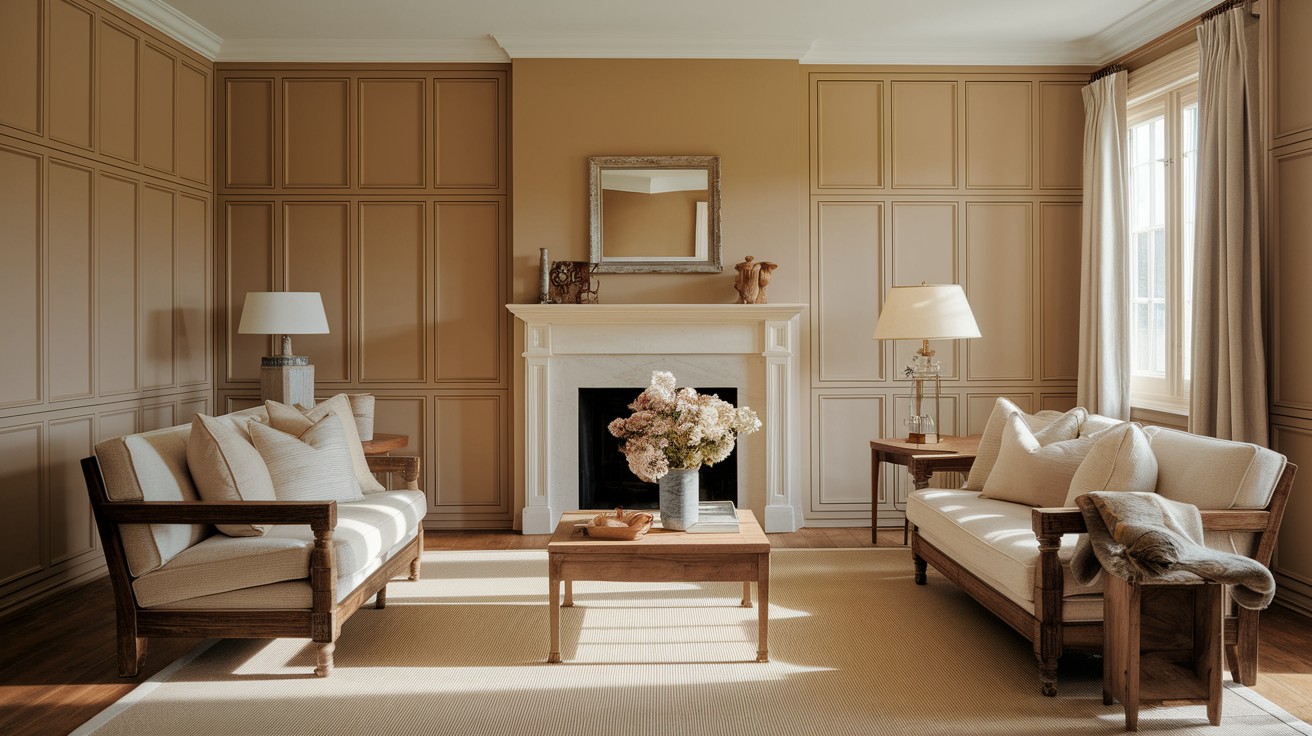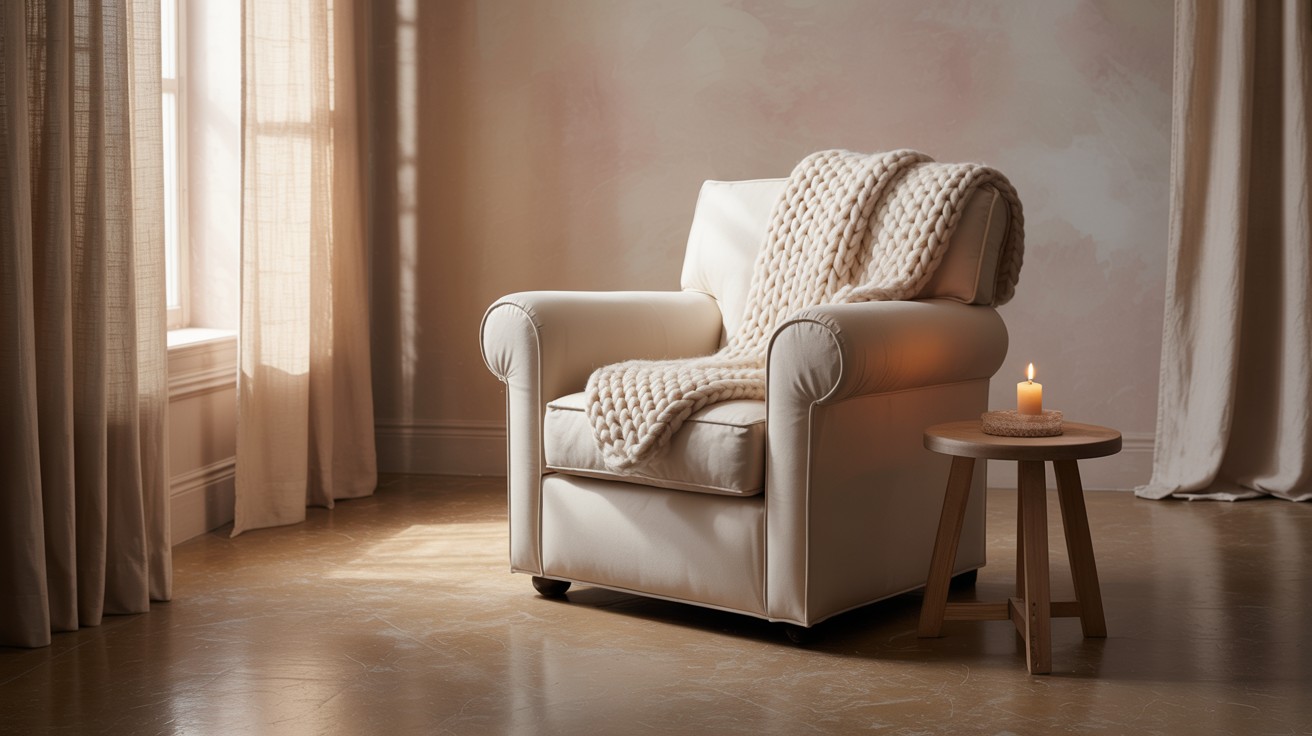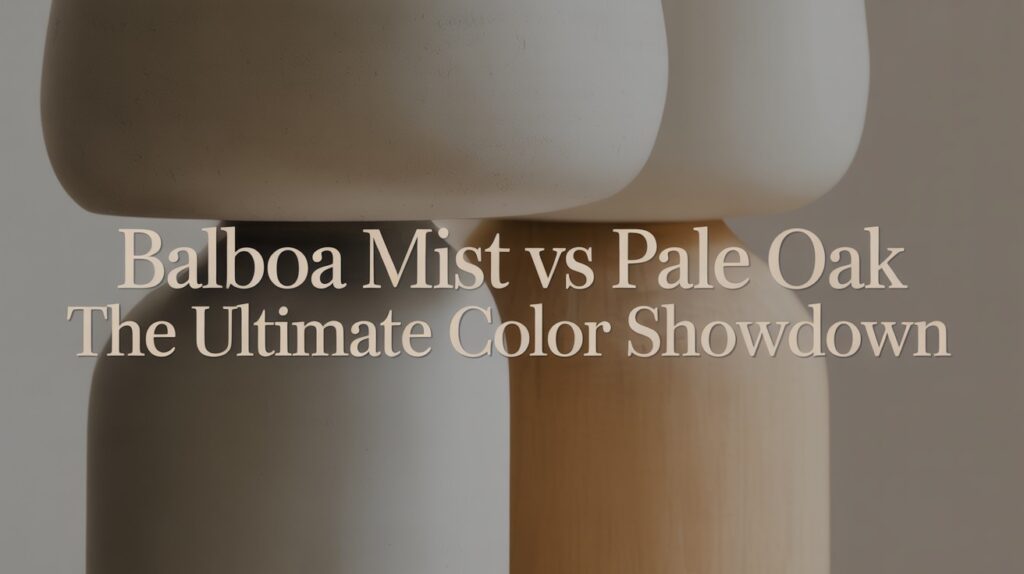When selecting neutral paint colors for your home, the choice can significantly impact the overall feel and atmosphere of your space.
Two standout options from Benjamin Moore consistently earn praise from designers and homeowners alike: Balboa Mist and Pale Oak.
Both colors offer versatility and timeless appeal, but they each bring distinct characteristics that work better in different settings.
Making the right decision between these popular neutrals requires understanding how they respond to various lighting conditions, their subtle undertones, and how they complement different room functions.
In this comprehensive comparison, we’ll examine both colors side-by-side, analyzing their performance across different spaces and lighting scenarios.
By the end, you’ll have the knowledge needed to confidently choose the perfect neutral that aligns with your personal style and home’s unique characteristics.
| Comparison Factor | Pale Oak (OC-20) | Balboa Mist (OC-27) |
| Light Reflectance Value (LRV) | 68.64% (Higher – Brighter) | 65.53% (Lower – Slightly Darker) |
| Primary Undertones | Beige, Taupe, Pink | Violet, Gray |
| Temperature Rating | Warm (7/10) | Neutral-Cool (4/10) |
| Best Room Types | Living rooms, Bedrooms, Kitchens with wood accents | Bathrooms, Modern kitchens, Contemporary living spaces |
| Style Compatibility | Traditional, Farmhouse, Transitional, Cozy modern | Contemporary, Modern, Minimalist, Industrial chic |
| Lighting Sensitivity | May pull pink in fluorescent light | May appear violet in low/dim light |
| Best Accent Colors | Warm whites, Creams, Soft blues, Sage greens | Crisp whites, Navy, Charcoal, Cool grays |
| Ideal Trim Pairing | White Dove, Cloud White | Simply White, Pure White |
Meet the Contenders: An Overview
Understanding the fundamental characteristics of each color provides the foundation for making an informed decision.
Both Balboa Mist and Pale Oak offer unique qualities that cater to different design preferences and functional needs.
What Is Balboa Mist (OC-27)?

Balboa Mist appears as a light warm gray featuring subtle violet undertones that create a balanced, airy feel ideal for modern homes.
With an LRV of approximately 65.53%, this shade absorbs slightly more light than its counterpart.
The violet influences provide sophisticated depth, making it exceptionally suitable for clean, contemporary spaces.
This color maintains a fresh, uncluttered appearance while adding just enough warmth to avoid feeling cold or sterile in most residential settings.
What Is Pale Oak (OC-20)?

Pale Oak combines soft greige qualities with gentle beige and taupe undertones, resulting in a naturally warm, cozy atmosphere.
Its higher LRV of around 68.64% means greater light reflection, creating brighter, more open-feeling spaces.
The beige characteristics make this color particularly compatible with traditional and classic interior styles.
Pale Oak excels at establishing inviting, comfortable environments that feel welcoming and lived-in rather than minimalist or stark.
Undertone Breakdown: Warmth vs. Coolness
The subtle undertones in each color play a crucial role in determining how they’ll appear in your specific space.
These underlying hues can shift dramatically based on lighting conditions and surrounding elements.
Pale Oak Undertones

Pale Oak naturally leans toward the warmer side of the spectrum, particularly revealing pink and taupe tones when exposed to low light conditions.
This color demonstrates notable flexibility, shifting its appearance based on lighting quality and surrounding furnishings.
The warm undertones help create a cozy, inviting atmosphere that feels naturally comfortable in most residential settings, making spaces feel more livable and welcoming.
Balboa Mist Undertones

Balboa Mist carries slightly cooler characteristics, with violet and gray hints that become more pronounced under certain lighting conditions.
In dim or artificial lighting, this color may reveal noticeable purple tones that can complement or clash with existing decor.
These cooler undertones contribute to its modern, clean aesthetic while maintaining sufficient warmth to avoid feeling completely cold or institutional in appearance.
Pros and Cons at a Glance
Making an informed decision requires weighing the strengths and potential drawbacks of each color. Here’s a clear breakdown to help you assess which option aligns better with your needs.
Pale Oak

Pros
Pale Oak reflects more light due to its higher LRV, making rooms feel brighter and more spacious.
The warm and soft characteristics create an inviting atmosphere that feels naturally comfortable.
This color blends beautifully with traditional or farmhouse style decor, complementing wood elements and classic furnishings seamlessly.
Cons
In spaces already filled with warm-toned elements, Pale Oak may appear overly beige, potentially creating a monotonous look.
Under specific lighting conditions, particularly fluorescent or certain LED bulbs, this color can pull pink tones that may clash with your intended design scheme.
Balboa Mist

Pros
Balboa Mist offers a clean appearance that works well across different design styles.
It demonstrates flexibility when paired with both warm and cool color palettes, making it versatile for various decorating approaches.
This color excels in modern aesthetic applications where a fresh, contemporary look is desired.
Cons
In low light conditions, Balboa Mist may appear violet or purple, which could conflict with certain decor choices.
Additionally, it reflects slightly less light than Pale Oak, potentially making smaller rooms feel somewhat less bright and open.
Tips for Making the Right Choice
Selecting between these two popular neutrals requires careful consideration of your specific space and preferences.
These practical tips will help ensure you make the best decision for your home.
1. Test Paint Samples
Always use real paint swatches or peel-and-stick samples rather than relying solely on digital representations or small color chips.
Apply large samples to your walls and observe how each color performs in different lighting conditions throughout the day.
Natural morning light, afternoon sun, and evening artificial lighting can dramatically alter the appearance of both colors, revealing undertones that may not be immediately apparent.
2. Match With Existing Finishes
Consider how your current floors, countertops, cabinetry, and trim will interact with each color choice.
These permanent fixtures can significantly influence how the paint appears on your walls.
Wood floors with warm tones may enhance Pale Oak’s cozy qualities, while cool marble countertops might complement Balboa Mist’s clean aesthetic.
Take photos of your samples alongside existing finishes to better visualize the complete look.
3. Know Your Style
Your personal design preferences should guide your final decision.
If you gravitate toward cozy, traditional, or farmhouse aesthetics that prioritize comfort and warmth, Pale Oak will likely serve you better.
For those who prefer sleek, modern, or contemporary styling with clean lines and minimal clutter, Balboa Mist offers the perfect foundation for your design vision.
Conclusion
Both Balboa Mist and Pale Oak have earned their reputation as versatile, neutral favorites among homeowners and designers for good reason.
Each color brings distinct qualities that can complement different spaces, lighting conditions, and design styles beautifully.
The key to making the right choice lies in testing both options within your own home environment.
Take the time to observe how each color performs with your specific lighting, existing finishes, and personal aesthetic preferences.
Remember that both colors are proven winners, there’s no wrong choice here.
Trust your instincts and select the option that feels most harmonious with your space and lifestyle.
Your home should reflect what makes you feel comfortable and happy, so go with the color that resonates most strongly with your vision for the space.
Frequently Asked Questions
Which color works better in small spaces?
Pale Oak typically performs better in smaller rooms due to its higher LRV of 68.64%, which reflects more light and creates a brighter, more open feeling. However, Balboa Mist can also work well in small spaces if you prefer a slightly more intimate atmosphere with its subtle violet undertones.
Do these colors look different in north-facing vs south-facing rooms?
Yes, both colors will appear differently based on room orientation. Pale Oak may look more beige in warm south-facing light, while Balboa Mist’s violet undertones become more pronounced in the cooler light of north-facing rooms.
Can I use the same trim color with both paints?
While both colors work with white trim, they pair best with different whites. Pale Oak complements warmer whites like White Dove or Cloud White, while Balboa Mist looks better with cooler, crisper whites like Simply White or Pure White.
Which color is more forgiving with furniture choices?
Balboa Mist tends to be more flexible with both warm and cool furniture pieces due to its neutral-cool temperature. Pale Oak works beautifully with warm-toned furniture but may clash with very cool or stark modern pieces.
How do these colors perform in rooms with limited natural light?
In low-light conditions, Pale Oak maintains its warm, cozy feel but may appear slightly flat. Balboa Mist can show more violet undertones in dim lighting, which may or may not complement your space depending on your existing decor and preferences.

